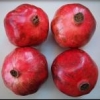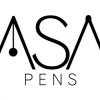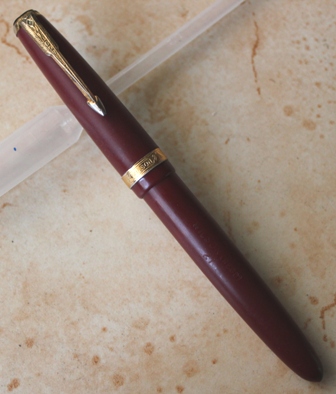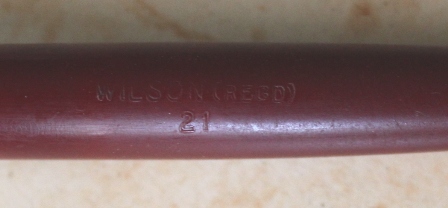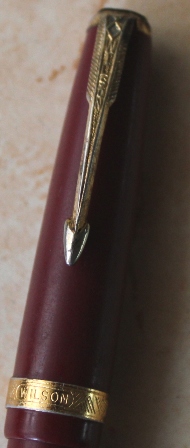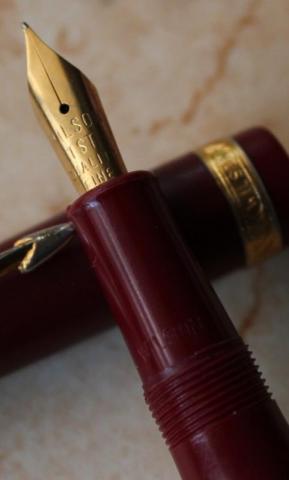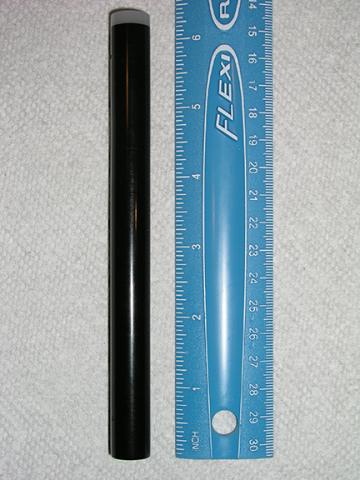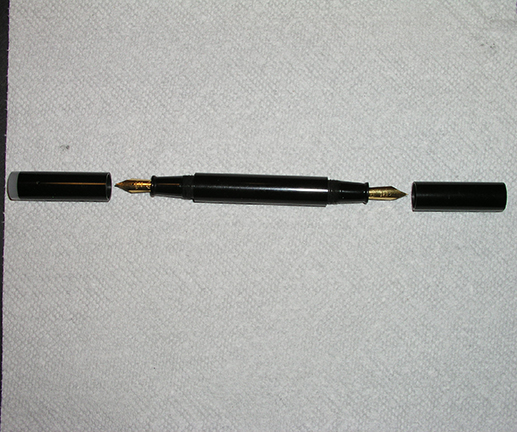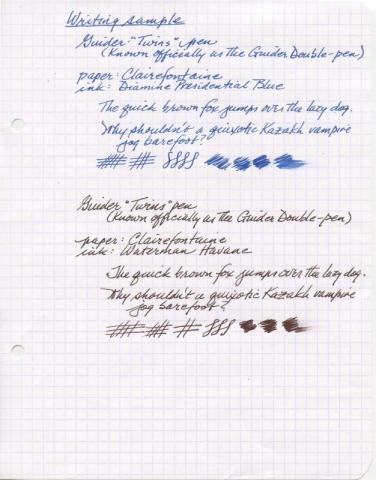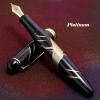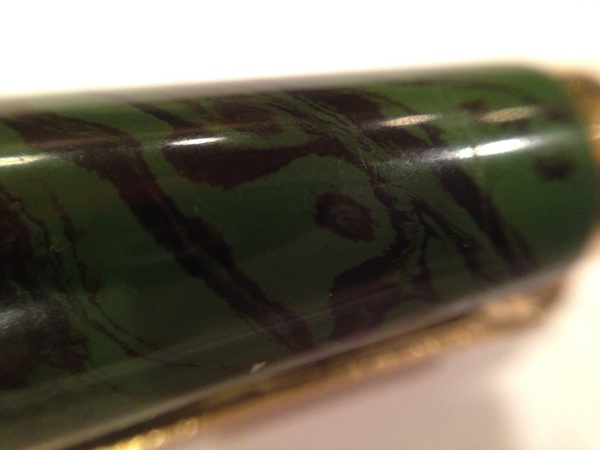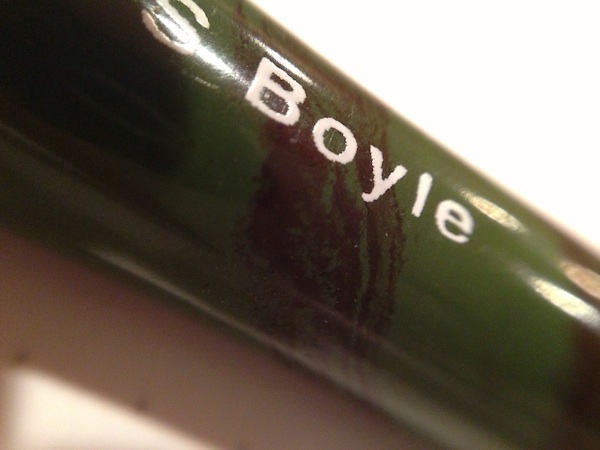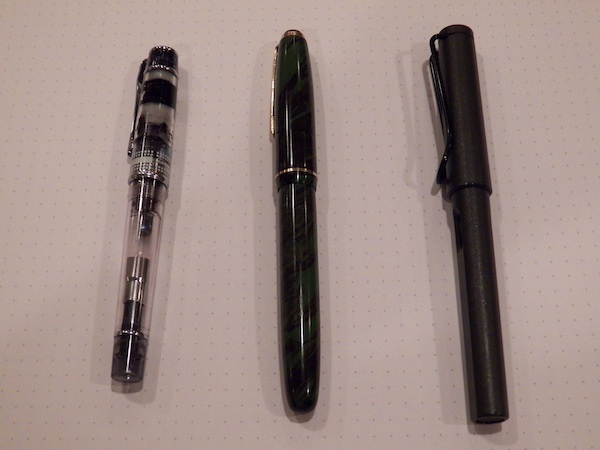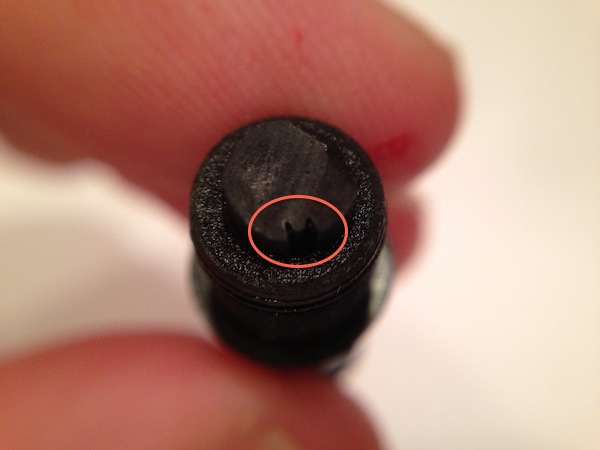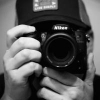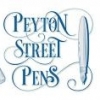Search the Community
Showing results for tags 'eyedropper'.
-
Is It Possible To Make A Seam On My Pen Watertight?
Obedai posted a topic in Fountain & Dip Pens - First Stop
I love turning my cartridge/converter pens into eyedroppers because it is easy and lets me hold so much more ink. However, I have a Platinum Century 3776 pen that I am having trouble converting. I want to convert it because it is in the semi-transparent blue color, which makes it lovely for eyedropper filling, and I just love the way the pen writes. However, these pens have a small golden band near the bottom of the barrel that leaks out ink if I eyedropper fill it. Is there any way that you guys know of to seal this seam so that it does not leak ink? Right now I just wrap it in a single layer of electrical tape, but that is obviously ugly and not ideal. Any help you can give would be appreciated.http://fpquest.files.wordpress.com/2012/12/platinum3776bluechartres_oncap.jpg- 19 replies
-
- eyedropper
- sealing
- (and 6 more)
-
This dropped through the letterbox an hour ago. I haven't had much time to play with it, but I couldn't wait to show it to you all. Here she is: a BCHR Mabie Todd Swan 1500 eyedropper, with a pretty gold-filled band. Big thanks to Deb from Goodwriters, who, as always, was an absolute joy to deal with. The cap is friction fit and posts very comfortably - the lack of a clip is actually something I always rather like in a pen (1500s with after-market clips are quite common, and I am pleased to have found a pen without one), but your preference may differ! Uncapped: Of course, the really interesting thing about the 1500 is the nib and feed setup. The 1500 was made in the 1910s, when most companies had abandoned the fiddly over/under feed for ladder feeds. Mabie Todd carried on with the over/under, and it's a wonderfully reliable mechanism - at least when Mabie Todd are making it (some vintage pens with this setup can be quite blobby). This nib is beautifully flexible; it's not the most responsive nib I own, but it feels very brush-like to use. Here are some pictures of the nib and feed, because I know that's what you're all interested in: I didn't take a picture before I filled the pen, but the feed's long back and accompanying twist of silver wire is interesting, and Deb has a picture from a different 1500 on her blog. I've owned this pen for all of about 70 minutes, so this is a very perfunctory look (and Tanzanite is too wet an ink to use in it, in retrospect - apologies for the scrawl). I've not written much with it yet, but I have a feeling we're going to be firm friends. The nib is smooth, wet and painterly, and the slimness of the barrel suits me perfectly.
- 2 replies
-
- eyedropper
- mabie todd
-
(and 3 more)
Tagged with:
-
I've been reluctant to make an eyedropper pen so far because of the potential for leaks at the section/barrel threads. Looking at the pen I got with a bottle of Noodler's ink, there's an o-ring that helps seal the joint -- but the only rings with about 8 to 9mm diameter that I've been able to find are much too thick for the purpose. Do you think an o-ring is unnecessary? Do you have a source for o-rings suitable for this application? Thanks!
-
Not much is known about this company. We know that Wilson Pen Company was one of the significant pen manufacturers in India. They existed since 1939 as Wilson. They were headquartered in Bombay, India. (I learnt somewhere that they named their company Wilson, because the nibs they imported from USA during wartime had Wilson mentioned). During my school days, I remember Wilson was an envious brand. They used to come in many many models, introduced frequently and often high class replicates of famous Parker models. The most famous were the Wilson jotter pens & also a ball-point pen called "4-point pen" (used to write in 4 colours) Wilson actually paved the way to many western name brands in India like Kingson, Diplomat, Artex etc. They used to come in a plastic boxes mostly as pen sets. The boxes resembled & also open like the present day, manual mercury based "blood pressure monitoring" instrument. I had many Wilson pens but by now have lost all of them, but the pens were always in my mind. Recently, a friend of mine told me that he had a Wilson Fountain Pen, which he never used, since he fancied ball-points only. Thus came to my hands this beautiful Wilson 21, a deep red colour pen, with gold-plated clip and a cap band. (resembles vintage Parker) The pen posted The etching in the barrel "Wilson Regd" & 21 The Cap with clip & Band, "Wilson" is inscribed in both places. The Nib..Here to "Wilson" is written in nib, feed & Section Hope you liked reading about Wilson 21...
- 11 replies
-
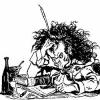
Review: Innovative Pen From India, The Guider "twins"
Woodnut posted a topic in Fountain Pen Reviews
I have just had an opportunity to ink up a fountain pen produced in India that only days ago came out of the prototype stage and is now available to the public in limited numbers. It is a stunning innovation in Indian pen design and manufacturing, and very well executed. Best of all, its price is affordable for the overwhelming majority of fountain pen enthusiasts. The pen is a Guider "Twins." Designed independently and placed into production by Mr. Lakshmana Rao, the respected head of India's Guider Pen Works, it features two nibs, each with its own ink reservoir, at opposite ends of a black ebonite body. For all its 6.25" (15.8cm) length, the Guider "Twins" is lightweight, a special quality of ebonite, which is the characteristic material of quality Indian pens, and widely used by American fountain pen manufacturers until they switched to plastic in the 1940s. Each reservoir holds approximately 1.35ml of ink. That amount -- 30% larger than what many cartridge converters hold -- is more than adequate for average writing purposes, while serving to mitigate against ink "burping," a well-known feature [not a bug; hat-tip to Microsoft] of eyedropper pens. ("Burping is generally explained as the result of heat from your hand being transferred to the ink reservoir, which expands the volume of the air pocket in the reservoir as the amount of ink draws down and the amount of air exchanged into the reservoir grows in size by replacing the ink.) The smaller volume of ink which each reservoir of the Guider "Twins," and thus the ultimate size of the air pocket, bodes well for overcoming the "burp" phenomenon. The body, caps and sections of the pen are all ebonite. The caps are flat. One cap, however, is topped by a round, flush disk composed of acrylic. (The disk on the one I acquired, shown above, is white; another version of the same pen sports a red acrylic disk.) Against a ground of highly polished, lustrous ebonite, this end piece lends a sleek, dramatic flair to the pen's design. It also serves a welcome functional purpose: to remind you, if you use many inks, that one end of the pen holds a different color or brand of ink. (Of course, it's up to the user to remember which end holds which color/brand of ink.) Filling each reservoir with a different color of ink is extremely useful not only to ink enthusiasts, but also to writers (like myself) who are now able to devote one end of the pen to writing first drafts, and the other end to mark up revisions -- without having to rummage through their fountain pen collections, trying to remember which pen is inked up with what color. With this pen, both colors are right at your fingertips. Of course, if you fill both reservoirs with the same color, you'll be carrying close to 3ml of ink -- nearly three times as much as a cartridge converter, with the added advantages that you'll be twice as likely not to burp as you write that long journal entry, love letter or next chapter of your novel. The Guider "Twins" nibs are iridium-point Guider nibs. Both nibs are fine, in both senses of the word: line width, and smoothness. Each provides a touch of feedback on Clairefontaine paper, but so little that it's not distracting. Fountain pen users familiar with micromesh and lapping film will be able to fine-tune their nibs with a few brief twirls of the tines. For the rest of us, these Guider nibs will be perfectly respectable "right out of the box." Here is a writing sample, made with two different inks: Two features of the "Twins" are of note: First, there is no clip. Something had to give in designing a pen with two nibs, and apparently it was the clip. That said, it is probably wise not to attempt to carry this peen loose in your shirt or blouse pocket. At 6.25", it is likely to fall out in a moment of rash movement (think: bending over to retrieve a paper clip), and it would be a shame to mar the highly polished finish of this pen. Rather, it would be best to carry it in a pouch (I am making one of leather at the moment), and even better, a pouch with a built-in clip that can be slipped over the fabric of a shirt or blouse pocket (a task beyond my current leatherworking skills). Another reason to acquire and use a pouch is that the designer and manufacturer have fashioned it from an ebonite rod that has been machined to be as perfectly round as possible. Set it down on its side, give it a gentle nudge and, absent a cap clip, it will roll -- and once it runs out of writing surface and gravity takes over, the next stop is usually the floor, and all too many of us are familiar with the consequences. A second thing to note is that the cap threads at each end are closely machined and not interchangeable, as a way to make sure you don't mix up which ink is where. Each cap is designed to thread easily and securely on its designated end of the pen. My suggestion is that if you inadvertently mix up the caps, be attuned to any possible resistance you may encounter as you replace the cap. If you sense resistance, try putting the other cap on that end, and chances are you will not meet resistance. Moreover, note that the caps unscrew when turned counterclockwise. When recapping, it is always good practice to first turn the cap in a clockwise direction until you hear a gentle "click." That means that when you then turn the cap counterclockwise, the threads will be properly engaged, and you'll be less likely to strip the threads. The Guider "Twins" just recently went into production and is available in limited numbers from FPN member Mesu. Her ad in FPN Classifieds displays the pen in higher-quality photos than I've been able to take. If I sound enthusiastic about this pen, I am. (Full disclosure: I have no affiliation with either Guider or Mesu, other than having previously purchased a Guider Marala through Fountain Pen Revolution, and this pen through Mesu.) I own a good number of Indian ebonite eyedroppers, including the ones just mentioned, and a Guider super-mini, a Ranga Duofold Model 3, a Ratnamson No. 15, and a Gama Supreme. The design of this Guider "Twins" pen promises to give Indian pen design and manufacturing a shot in the arm, and to boost Indian ebonite eyedroppers from a niche market to a real contender in the global pen market. Innovative design and attentive, handcrafted production make this a desirable pen in any collection.- 12 replies
-
So, this is it, my first review. I have not been a member of the forum for long and really don’t have much experience writing reviews. I hope this will be useful and any criticism is welcome so that I can improve future reviews. Butterfly 311TG: I was recently randomly going to shops looking for fountain pens and found this one (with several others) at an old shop near my house. I had never used a pen of this make before and so I picked one up. It is certainly not an award winning pen in looks or build quality but it is certainly worth a review just because it is a nice pen to write and that too when it is probably one of the cheapest pens in the world. 1. Appearance and Design: 7/10 As I mentioned in the introduction, it is not an award winning pen in this segment. It is a very sober looking pen and looks pleasing in the first look. This was only available in blue so I don’t know if there are other options available. The cap has a good design with all its gold elements. The barrel has a cigar shaped tapered body and the cap screws on the barrel. The design of the pen is actually very good. The pen has a very convenient clear ink window and it does the job very well. The ergonomics of the pen are really nice. It is comfortable to hold and the section is not slippery at all. The threads do not irritate no matter where you hold the pen. Un-posted the pen is fairly decent size and posted the pen becomes very convenient to use, even for people with large hands. 2. Construction and quality: 5/10 While the tolerances of the pen are decent, the overall quality is rather poor. The pen looks plastic and the materials actually feels like recycled plastic. The make and model is screen printed on the barrel but is legible. The clip is of useless as it bends every time I put it in my pocket. Also the clip is permanently bent towards one side and it looks like a manufacturing flaw because I cannot straighten it just by hand. The gold paint on the cab band and the clip has already started coming off and the plastic of the pen is also very prone to scratches. 3. Weights and Dimensions: 6/10 Length: Capped – 134mm Uncapped – 122mm Posted – 148mm I do not have callipers to measure the dia but the pen is actually on the slim side so that might be a downside to people who like thick pens. I personally like the pen as it is comfortable to hold. As far as the weight go, well the pen is light, very light. Actually, it is so light that it becomes annoying to use it without posting it because you just don’t feel you are holding something. After posting it becomes usable but still a very light pen in my opinion. 4. Nib and Performance: 7/10 Now here it has both pros and cons. The pen has a gold coloured steel nib, which is as hard as a nail and I only realised after coming home that there is no tipping material on the nib whatsoever even though the nib says – “Platinum Power Point” which is just hilarious. The tines were completely misaligned and it took me about an hour to fix the nib and get it in writing condition. Then again the nib feels smooth although it has a lot of feedback. The feedback is somehow not scratchy and annoying. I mean even on very poor paper it did not dig into the paper or pull out fibre. The feed on the other hand is a beauty. The pen has an ebonite flat feed which keeps up the flow no matter how fast you write. Overall, the performance of the pen is nice. It is awesomely wet (the way I like it) and although the nib is a western fine, the pen writes so wet that it writes like a medium. I somehow enjoy writing with the pen even with its feedback. 5. Filling system and maintenance: 8/10 It is an eyedropper filler pen. One either loves it or hates it. I personally like eyedropper pens, so I would not complain, but if you do not like the hassles of the ED pens then this pen is not for you. Compared to other ED pens I have it does not hold a lot of ink but still holds a decent amount (a little less than 2ml) The nib and feed are friction fit and come out for easy cleaning which is really convenient when cleaning the pen. 6. Cost and Value: 9/10 The pen set me back around 20INR which is roughly 31 US cents (as of 14-11-13) so to get a pen for that price which writes well and one that I like writing with, I would say it is pure value for money. 7. Conclusion: 7/10 I would say a very decent everyday writing pen for students and other people who have a tendency to lose their pens. That said it is not a pen for everyone given its feedback and light weight. Plus it is not pretty. But as a pen I would say it deserves that 7/10 because it is a reliable writer, has no startup issues, holds a decent amount of ink and is ergonomic to use. I would say it does what the pen was designed for “write” and it does that rather well. And finally a writing sample and size comparision (with a parker Beta and Schneider Base) Thank you for reading. Ankit Chauhan
- 24 replies
-
- indian pen
- eyedropper
-
(and 1 more)
Tagged with:
-
I have two, unrelated questions, both of which was posed to me today but actually stumped me... What is the actual purpose of a flex pen? Is it simply the line variation?(This was asked by a friend who can actually write nicely, unlike me) Is an eyedropper pen a good pen for trying out samples of inks?(This was asked by my history tutor and I had no clue at all)
- 16 replies
-
- eyedropper
- flex
-
(and 2 more)
Tagged with:
-
Hi, I have been reading so many good reviews about the Capulet that I need to try one out for myself. While browsing photos of the pen, I noticed that the barrel and nib section do not appear to have any metal parts to corrode with prolonged exposure to inks. Futhermore, the barrel on the walnut finish (which happens to be my preferred finish at this time) appears to be a single piece. So it seems that with minor effort, the pen is a viable eyedropper host. So my question to owners of the pen (and of course to Mary): is the ED conversion possible or am I off my rocker? Of course filling the barrel with ink is only a small part of the story, a major concern being wetness and ink flow control. So, I appreciate any insight you can give me. Anyway, ED conversion notwithstanding, I shall be ordering a walnut Capulet soon. Cheers.
-
Noodler's Ahab + Sheaffer Feed = Good Eyedropper
recluse posted a topic in Fountain & Dip Pens - First Stop
I am among those (few?) lucky guys who didn't have problems with Noodler's pens. At the same time, there are some features that I'm not crazy about (these are all personal preferences, of course) and it looks like I've found a work around for one of them. It's appeared that I'm not fond of Ahab's filling mechanism. It works fine but the ink stuck in the piston rod drives me nuts. I know how to advance that ink to the nib but I don't like the procedure. And I know that removing the breather tube prevents the ink intake into the piston rod but ink can still get into there afterwards. One solution is, of course, to cover the hole in the piston but I don't know how to do this securely and reversibly at the same time. I still might return to this later. Another way is to use the pen as an eyedropper. This is when some internal imperfections of my Ahab (or even straight design flaws) became prominent. It didn't want to hold the ink. The pen was gushing right after filling. Furthermore, once a sbstantial air pocket was formed the pen started to drip the ink. Thus the eyedropper option was seemingly out. One day I've read about using Sheaffer's feeds in Indian eyedroppers and it rang the bell, thanks to, let's say, certain structural similarities between Noodler's pens and pens of some manufacturers in India. I have a couple of Sheaffer pens, which I couldn't make to work to my satisfaction. It's turned out that the standard feed taken from a plastic school pen fits wonderfully into the Ahab. Now to results. Positive outcomes. I am able to use my Ahab as an eyedropper. Moreover, I've finished two complete fills almost without usual problems, meaning no burping at the end! This should be elaborated. When the ink level gets low, say, to the last quarter, the pen becomes noticeably wetter but not too much. During the first fill, when the level dropped to the last milliliter or so the pen once misbehaved and was about to burp when I was writing on the porch (it was about 90 F that day), while inside there were no problems and the burping tendencies didn't reappear when the pen was taken inside and brought out again. I don't have an explanation for this. Possibly this was an effect of mismatched thermal expansions of the grip and the feed or something. During the second fill there were no problems but the pen was kept inside all the time. Negative outcomes. Well, non so far. General remarks. 1) I think people would like to know whether the Sheaffer feed cures the railroading problem. I cannot testify confidently as I don't use the flex nib. I've tried once with the new feed. It seemed that the ink supply got more steady but nevertheless I was able to make the pen railroad, but that's not difficult. So, how the Sheaffer feed affects the performance of the flex stock nibs should be studied separately. 2) Can the Sheaffer feed be used in Konrads? Without modifications, not really. The feed has this protrusion at the back end and it interferes with the piston. The piece can probably be cut off. I didn't try this. 3) Whether Sheaffer's feeds can be found separately I don't know, but cheap Sheaffer pens can be easily bought for a few dollars apiece on eBay. Overall, I'm very satisfied with the modified Ahab (is it still Ahab if it only has Ahab's body and the cap?). I can see it being a frequent member of the rotation.- 2 replies
-
- ahab
- eyedropper
-
(and 2 more)
Tagged with:
-
In my quest to find a simple, back to basics, no frills eyedropper, I stumbled across the Noodler's Aerometric Ebonite filler. I am totally digging this pen! Smooth simple body, just BASIC!! The problem is...I can't seem to find anything on where to buy it now. would anyone have any leads on where I could buy one or have one that they would be willing to sell? FPGeeks did a review on it a while back, here's the link: http://fpgeeks.com/2012/01/noodlers-aerometric-eyedropper-ebonite-fountain-pen-the-awesome-review/
-
First Impressions Tyler, from Organic Studio, had posed on Facebook, a few weeks back, that the was trying a line of pens and was offering them to beta testers for a reduced price. In the post, he showed a group of five ebonite pens of varying sizes and of four different colors. The smallest was the Mendeleev. It looked too small and thin. The next two were the same size, the Boyle and the Alchemist, the later having a hooded nib. The next size was the Lavoisier, which looked too big fro my small hands, and the final looked like a large cigar, the Special. The colors were black, red, brown, and green. I found the green most attractive and the Boyle most desirable. When I pulled it out of the wrapper, I thought it was of rather cheap or poor quality. It was light, the fittings weren't terribly shiny. The white embossed name on the pen was unique in my experience and seemed poorly done. This impression would prove to be false. Appearance and Design I'm a sucker for the look of ebonite pens. This one delivers that, very well, especially in the cap. It looks like black ink flowed into the fabric of a healthy leaf. This, along with the excitement of owning one early on in production, attracted me most to the pen. Embossed on one side is "OS Boyle" in white stamping. At first this attributed to my impression of it being cheap, but as I held it and looked at it and wrote with it, I felt like I returned to the 1920's (why? I have no clue). The white lettering gives it an old-timey feel. The fittings seem to be made of plastic or a dull metal. There is a band at the bottom of the cap. The clip starts at the black finial and comes down. On the clip is Organic Studio's Indian manufacturer, Ratnamson Construction and Quality The pen is light. At first, I chalked it up to cheap, but then I got the idea that it was intentionally made light. This is the kind of pen with which a book could be written. Your hand can use it for long periods of time without fatigue. That makes the pen a serious though the extended writer. The clip looks weak but again looks are deceiving. I can withstand a bit a beating. It's solidly build and yet has enough give to be put in and taken out of pockets without much difficulty. The grip section is very comfortable especially for my small hands. Larger hands and fingers might find themselves on the top part of the threads. The little lip disallows slippage. Speaking of the threads, there are 9-11 threads for the cap, so ... there is a worry that this cap will 'accidentally' fall off. It secures itself on there like a child to his father's leg. This isn't a quick draw pen for sure, not one fore mere signatures or quick notes. It expects you to sit down and write. Also, there is no need to worry that ink from the body will leak out. There are the same if not more threads to detach the body from the grip sections. It thoroughly seals the body to the grip section. It doesn't have the rugged feel of a Lamy Al-Star, but it isn't a fragile pen either. It might, in certain conditions, crack. So I wouldn't take this on a hunting trip despite its camaflouge-esque look. It would keep on the desk or in a case. if being carried around. Weight and Dimensions As I've mentioned previous, this is a light pen. It feels about the weight of a Pilot Prera, or another similar build small pen. I have a picture here of its comparative size to a Prera and a Safari. It posts well without any difficulty and remains there solidly. It is the perfect size for my hands but will still work well in larger, hands when posted. It also remains balanced when posted. The cap doesn't make it top heavy. Nib and Performance Before I go into its performance, the facts: 1) its a two tone German-made iridium nib 2) its only made in medium at this time This is where, originally, the pen failed miserably. I filled it with an Italian scented ink that smelled like Pine and had decent color. Because there was a small space for the ink to flow to the feed I wanted to use an ink I didn't care about that much, just in case in wouldn't work. I filled the body, flooded the feed by turning it nib down for a few minutes and then set it aside to let it move more naturally. About 10 minutes later, I took it up to write. It scratched and nothing came out. I pushed down hope to open it up and it finally flowed. "Great! It wrote!" I thought. So I set it aside on my desk to do something else and picked it up an hour or so later. 30 seconds of scratching and I had to unscrew it to make sure there was ink in the body. I wet the nib and it started again. Then, I put is aside for when I had time to write this review. A week later, again it was dry. I wetted the nib, but this time nothing came out. The body was full of ink! I cleared out the ink. Cleaned the pen as best I could and refilled it the next ink in my rotation, Chesterfield Ruby. This became a whole new pen. It flowed much more evenly and didn't even dry up after sitting for periods. With that said, the nib started scratchy with the Ruby, but as the ink flowed, the smoother the nib got. It's not a gold nib, but it doesn't feel like chalk on a chalkboard anymore. It does take two or three strokes to get started, if you've let it sit for longer the a few hours, but after that it doesn't need anymore. It hasn't skipped at all. It does seem to work better with some inks, or it could've been that there were manufacturing gunk in the feed. As for the line itself, it maintains a good consistent line. It holds the size of line between a Lamy M and F. I prepared this review in a paperblanks notebook and it handled well. It writes well on Rhodia as well. The nib seems to be form fitted into the grip section but I couldn't pull it out barehanded. Filling System and Maintenance I received the eyedropper version. There is also a version with a sack, but, to me, the sack is superfluous. This baby holds a good amount of ink. (Exact quantities I don't know, but at least a half of a syringe purchased from Goulet). What's very different from any other pen that I've seen is the channel were ink flows from the body into the feed. It about the size of a needle. It's tiny. I originally though I received a defective pen because it looks like there's a plug in there. That being said, thick high pigmented inks might have trouble flowing through it. This pen isn't easy to clean either for the same reason. You can't flush the pen out very well because the hole is so small and if you do, you'll need a larger space for excess water spillage. It doesn't have the east of a cartridge/converter. Cost and Value It's sold at most retailers for $25 USD, which I think is a fair price for the pen. It give the student an option for a cheap ebonite and the eyedropper experience/benefit. In that way, has found a niche with very few comparable competitors. Conclusion I'm glad I didn't judge this book by its cover. The more I wrote with it the more I liked it. The scratch has greatly decrease after extended writing, making it a joy to write with. It would definitely be an option in my mind as "the pen" for my next work of fiction because of its light weight and high ink capacity. Well, worth your $25.
- 9 replies
-
- organic studio
- boyle
-
(and 2 more)
Tagged with:
-
Hello, I pulled the trigger and made an offer on two pens I found at a local antique mall. I had seen the pens Tuesday, just before closing time, and fell in love. They were in two different cases at opposite ends of the room, but owned by the same vender. Today I went back and got to sit down and look at them side by side. I made an offer and the vender took it. The smaller one is 5 inches long capped and the longer one is 5 1/4 inches long. The smaller one has a Pilot Warranted 14K #2 nib. The longer one is a Warranted 14K #3 JIS nib. Both are marked R14K on the clips and band with minimal brassing on the shorter pen. The larger pen was well loved, the cap is worn, even some of the urushi is worn above the band in one area. Someone carried and used this pen. Its bori pattern looks to be similar to one Stan had posted and has on his website. It is not the common pattern. The shorter pen is in the more typical pattern with an area for personalization which is blank. Both show signs of ink around the shut-off rod. So with out further bragging, the pictures.
-
Hello all, I partook in the Limited Edition Ebonite Edison Morgan (say that 5 times fast) this year and I have been enjoying the pen immensely. It's my first Ebonite pen, but certainly won't be my last. I recently splurged a little and ordered a Fine, Full-Flex nib from Richard Binder for the Morgan (after seeing Brian Gray's video, I just couldn't resist). It arrived yesterday and I've been playing with it a good bit. I've noticed that the converter is a bit... um... lacking in volume. Basically I'm having too much fun, but my fun gets cut short because I run out of ink (OH THE HORROR!!!). I know that a lot of Brian's pens can be converted to eyedroppers. Is it safe to do this with an Ebonite pen? Is there anything I should worry about? I have the silicone grease and eyedroppers and what not on-hand, I just don't want to ruin the Ebonite or something. Any insight would be great. Thanks so much! Matthew
- 23 replies
-
- ebonite
- eyedropper
-
(and 5 more)
Tagged with:
-
I've just bought an Onoto piston filler at an antique shop. It's a BHR pen much like the top illustration in Marshall and Oldfield, 2nd ed., p.166, except that there is only an underfeed. The plug can be unscrewed and the rod pulled out although I've not tried to see how far it can be extracted with force. The section unscrews nicely from the barrel assembly, revealing the pointed end of the piston. I suspect that the pen has not been serviced in a long time. Having read M+O’s description a full overhaul is well beyond my current and likely future capabilities, In any case, the mechanism will always be fragile, which does not mix well with my innate clumsiness. As the section does unscrew so easily, I can envisage removing the section and using the pen as an eyedropper by dropping ink into the barrel with the section out, then refitting the section with silicone grease. This would, of course, depend on the rod/barrel seal being sound, but I’d expect to test that out after greasing the rod and working it back and forth a few times. I’d also expect to have to release the ink flow by opening the knob a touch (if I understand the mechanism correctly). So, what do Onoto experts see as the likelihood of being able to use the pen in this way, and are there any disadvantages, for example the possibility of damage or difficulty for future repairers due to ink getting into the wrong places?
-
I know this is an old topic, but this is my first attempt to convert a pen to an eyedropper, and I just wanted to share. I'm new to fountain pens, and I'm excited with the results of my conversion. This is a fun, new interest and thank you to all who share their knowledge. http://youtu.be/PZUf8OxHdjE
-
Boy, we sure don't see these every day! http://www.peytonstreet.com/pens/waterman/waterman_0518_9.jpg http://www.peytonstreet.com/pens/waterman/waterman_0518_2.jpg http://www.peytonstreet.com/pens/waterman/waterman_0518_4.jpg http://www.peytonstreet.com/pens/waterman/waterman_0518_1.jpg http://www.peytonstreet.com/pens/waterman/waterman_0518_7.jpg TERI
- 16 replies

